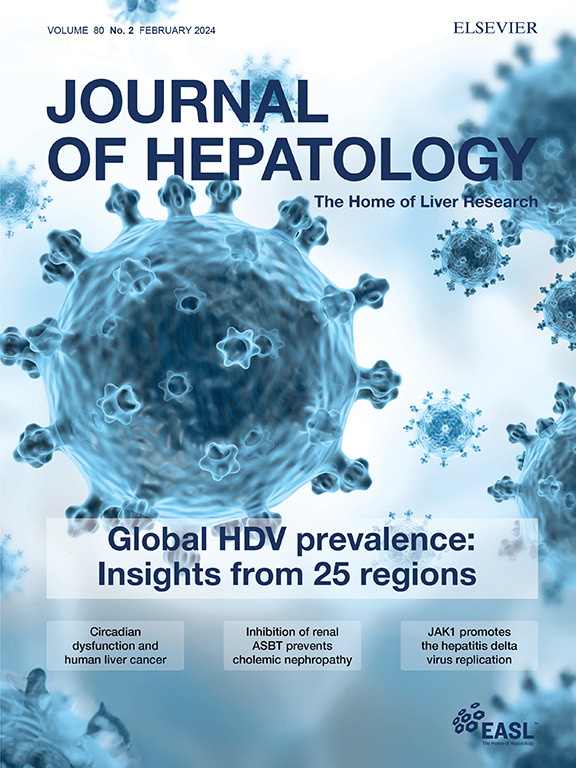羟脱氧胆酸通过促进m6a调节的新型抗纤维化靶点ETV4的表达来改善胆汁淤滞性肝纤维化
IF 26.8
1区 医学
Q1 GASTROENTEROLOGY & HEPATOLOGY
引用次数: 0
摘要
背景,目的静态肝纤维化是各种胆道疾病的共同病理特征。潜在的病理机制尚未完全阐明,这对发现新的药物靶点构成了重大障碍。本研究旨在评价羟脱氧胆酸(HDCA)对胆汁淤积性肝纤维化的保护作用,并确定ETV4是否为参与HDCA治疗作用的新的抗纤维化靶点。方法采用胆管结扎(BDL)和Abcb4-/-小鼠模型验证HDCA的治疗效果。通过对Etv4-/-小鼠进行BDL治疗,探讨Etv4在肝纤维化中的作用及HDCA的治疗作用。利用MeRIP-qPCR和IF/FISH技术研究n6 -甲基腺苷(m6A)修饰。结果在胆汁淤积症患者和小鼠中,shdca水平均降低,而补充HDCA可显著改善胆汁淤积性肝纤维化。HDCA通过诱导胆管细胞中ETV4的表达,诱导MMP9分泌,促进细胞外基质(extracellular matrix, ECM)降解。在胆汁淤积性纤维化患者和Etv4-/-小鼠的研究结果进一步揭示了Etv4在改善肝纤维化和HDCA治疗作用方面的良好作用。在机制上,HDCA促进m6A修饰ETV4 mRNA,促进IGF2BP1识别和PABPC1募集,从而抑制ETV4 mRNA的死基化,从而提高mRNA的稳定性、在p -小体中的储存和延长翻译时间。ETV4 mRNA上m6A位点的突变或敲低参与m6A修饰的关键基因显著地取消了HDCA的调节作用。结论本研究强调了ETV4是一个新的抗纤维化靶点,并证明HDCA通过促进m6a调节的ETV4表达来重塑ECM,为胆汁淤积性肝纤维化提供了潜在的治疗方法。影响和意义本研究深入探讨了胆汁淤积性肝纤维化的潜在机制,并提供了潜在的治疗靶点。该研究强调了ETV4作为一种新的抗纤维化靶点,对羟脱氧胆酸(HDCA)治疗胆汁淤积性肝纤维化的疗效至关重要。这些发现对科学界和胆汁淤积性肝病患者都很重要,为未来的治疗策略提供了有价值的见解,这些治疗策略侧重于调节m6a依赖性抗纤维化靶点(如ETV4)的表观遗传修饰,并利用HDCA开发新的干预措施。本文章由计算机程序翻译,如有差异,请以英文原文为准。


Hyodeoxycholic acid ameliorates cholestatic liver fibrosis by facilitating m6A-regulated expression of a novel anti-fibrotic target ETV4
Background & Aims
Cholestatic liver fibrosis is a common pathological feature of various biliary tract diseases. The underlying pathological mechanisms are not fully understood, posing significant obstacles to the discovery of new drug targets. The aims of the current study were to evaluate protective effects of hyodeoxycholic acid (HDCA) against cholestatic liver fibrosis and to ascertain whether ETV4 is a novel anti-fibrotic target involved in the therapeutic effects of HDCA.
Methods
The therapeutic effect of HDCA was verified using bile duct ligation and Abcb4-/- mouse models. Etv4-/- mice were subjected to bile duct ligation to investigate the role of ETV4 in liver fibrogenesis and the therapeutic effects of HDCA. The N6-methyladenosine (m6A) modification was investigated using methylated m6A RNA immunoprecipitation-qPCR and immunofluorescence/fluorescence in situ hybridization techniques.
Results
HDCA levels were decreased in both cholestatic patients and mice, while HDCA supplementation significantly ameliorated cholestatic liver fibrosis. By inducing ETV4 expression in cholangiocytes, HDCA induced MMP9 secretion, facilitating extracellular matrix degradation. Findings in patients with cholestatic fibrosis and Etv4-/- mice further revealed a promising role of ETV4 in improving liver fibrosis and in mediating the therapeutic effects of HDCA. Mechanistically, HDCA promoted m6A modification of ETV4 mRNA, which thereby promotes IGF2BP1 recognition and PABPC1 recruitment to inhibit ETV4 mRNA deadenylation, leading to increased mRNA stability, storage in P-bodies, and prolonged translation. Mutation of the m6A site on ETV4 mRNA or knockdown of critical genes involved in m6A modification significantly abolished the therapeutic effects of HDCA.
Conclusions
The present study underscores ETV4 as a novel anti-fibrotic target and demonstrates that HDCA remodels extracellular matrix by facilitating m6A-regulated ETV4 expression, offering potential therapeutic approaches for cholestatic liver fibrosis.
Impact and implications
This study delves into the underlying mechanisms of cholestatic liver fibrosis and reveals potential therapeutic targets. The research highlights ETV4 as a novel anti-fibrotic target that is essential for the therapeutic effects of hyodeoxycholic acid against cholestatic liver fibrosis. These findings are important for both the scientific community and patients with cholestatic liver diseases, offering valuable insights for future therapeutic strategies that focus on regulating m6A-dependent epigenetic modifications of anti-fibrotic targets like ETV4 and developing new interventions utilizing hyodeoxycholic acid.
求助全文
通过发布文献求助,成功后即可免费获取论文全文。
去求助
来源期刊

Journal of Hepatology
医学-胃肠肝病学
CiteScore
46.10
自引率
4.30%
发文量
2325
审稿时长
30 days
期刊介绍:
The Journal of Hepatology is the official publication of the European Association for the Study of the Liver (EASL). It is dedicated to presenting clinical and basic research in the field of hepatology through original papers, reviews, case reports, and letters to the Editor. The Journal is published in English and may consider supplements that pass an editorial review.
 求助内容:
求助内容: 应助结果提醒方式:
应助结果提醒方式:


